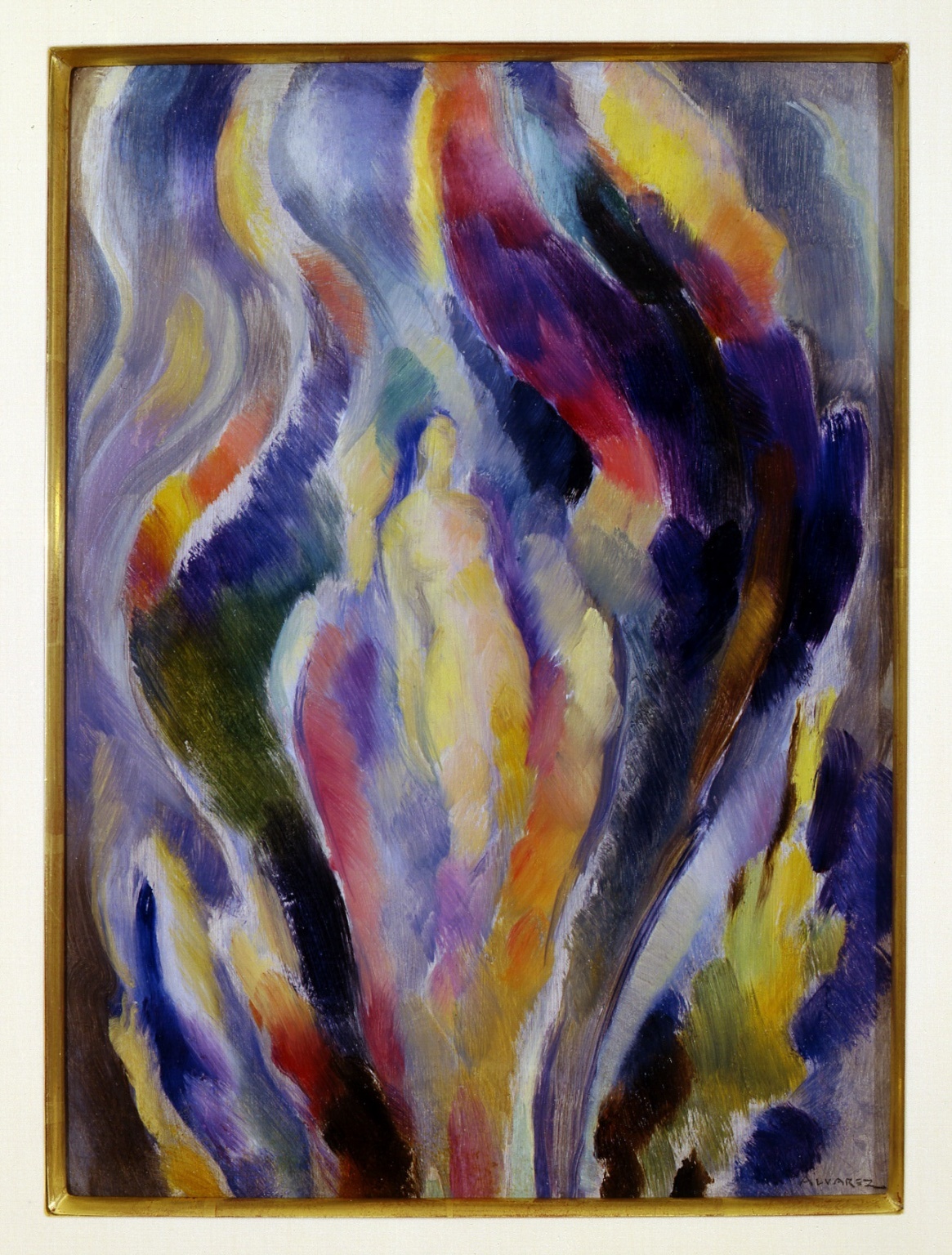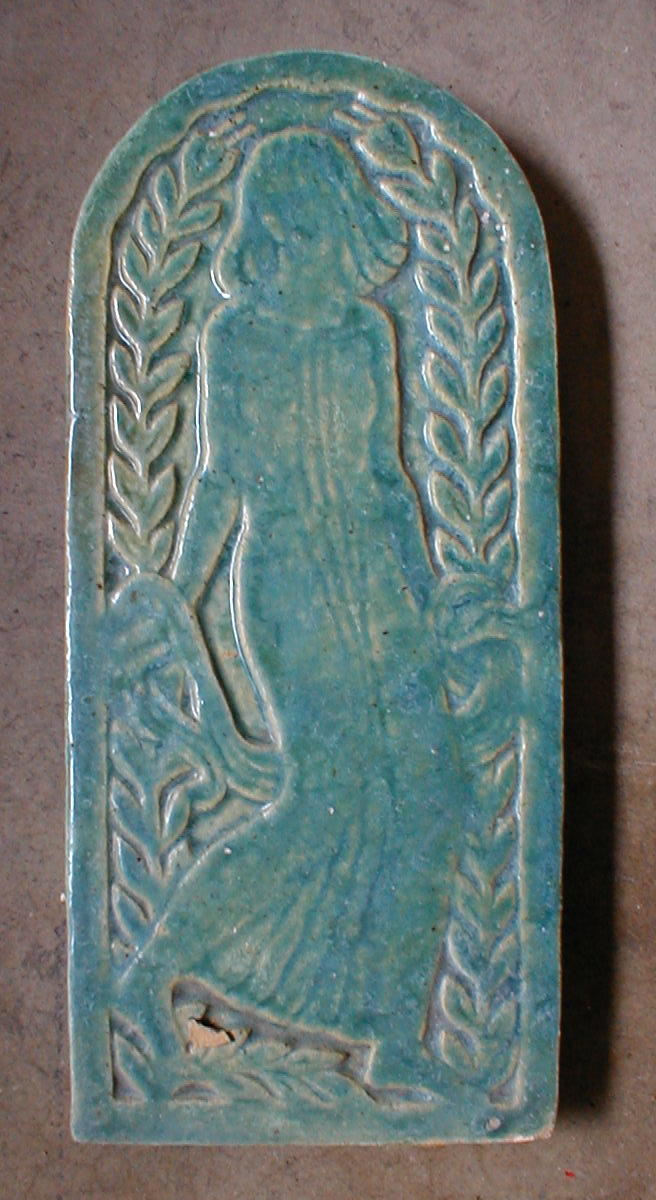|

Oil on cardboard, 13 " x 9 "
in.
The
2008 exhibit, The Art Students League of Los Angeles,
held at the Pasadena Museum of California Art, demonstrated the
strong influence Stanton MacDonald Wright (co-inventor of
Synchromism) had over his students. Alvarez, the daughter of a
physician, grew up in Hawaii and after moving to Los Angeles
studied with Impressionists John Hubbard Rich and William
Vincent Cahill, at which time she produced some of the area�s
most outstanding Impressionist figure studies. However, in the
early 1920s, under the influence of Wright and several
post-Impressionist artist friends, her brushwork became bolder
and her colors brighter. Like many local female artists she
preferred subject matter that could be painted in a studio, such
as figures/portraits and still lifes, and she tapped her
emotions and subconscious to occasionally create dreamy, fantasy
pieces. In Untitled (Figure in Colorful Waves)
all her influences come together as she captures a fantasy nude
in bright, Wright-like rainbow waves of color.
___________________________________________________________________
Mabel Alvarez (1891-1985)
Untitled (In the Garden),
c. 1923
Oil on canvas, 20 x 24 in.
Like many women artists, Mabel Alvarez
produced most of her works indoors in a studio and thus her
subjects ran to still lifes, portraits, and figural paintings.
Untitled (In the Garden), is a figural work, whose
stylistic similarity to Alvarez�s award-winning work Self
Portrait of 1923 probably dates it to about the same time.
The rich, saturated color and broad brushwork reflects her
influence from friends John Hubbard Rich and other painters of
the 1920s who gravitated to bold colors and expressive brushwork
in a kind of post-Impressionism. The identity of the model is
unknown. The canvas was discovered after Alvarez�s death in the
hands of her former dealer, Al Kramer, rolled up with others.
Provenance: Al Kramer (no 56 of Kramer inventory of
Alvarez paintings); exhibitions and publications:
reproduced in color in Glenn Bassett, "Mabel Alvarez, A Personal
Memory," American Art Review, v. XI, no. 2, April 1999,
p. 187; postcard made by Orange County Museum of Art in spring
1999; reproduced in color in exh. cat.: Mabel Alvarez: A
Retrospective, Laband Art Gallery, Loyola Marymount
University, LA, March 11 � April 11, 1999 and Orange County
Museum of Art, May 1 � July 18, 1999; exhibited, 75 Works 75
Years Collecting the Art of California, Laguna Art Museum,
Laguna Beach, Ca. April 2 - July 11, 1993, and reproduced in the
catalogue in color p. 33; reproduced American Art Review,
v. XII, no. 4, August 2000, cover and p. 179; reproduced
Orange County Register, Fine Arts, Sunday, May 16, 1999,
Show, p. 39;
_________________________________________________________________
Mabel Alvarez (1891-1985)
Untitled (Dancing Woman),
late 1920s

terra cotta with pale blue-green glaze, 13 � x 6 x 1 in.
Provenance: Al Kramer (no. 1 of Kramer inventory of Alvarez
works)
Untitled (Dancing Woman),
a ceramic sculpture, departs dramatically from the
Alvarez paintings discussed above in that it reflects some new
directions taken by the artist, who was always eager to try new
styles, subjects and media. Upon returning from a European trip
in late 1924, not only did she turn to decorative themes,
gaining her inspiration from reproductions in books on Chinese
painting, Persian art, East Indian and Tibetan art, but she
began to explore some of the many religions that arose in Los
Angeles including the ideas of Will Levington Comfort. About
the same time, with long-time friend, modernist artist Maxine
Albro, she became interested in clay as a medium. (California,
because of its many clay deposits, was a center for the
production of terra cotta tiles and other embellishments for
architecture as well as smaller items such as pots by both
individual studios and large commercial enterprises.)
Sculpting the clay in her own studio, she created painted and
glazed tiles, plaques, concrete bas reliefs, and a fountain.
The finished pieces were sent to the Italian Terracotta Company
for firing. Dancing Woman combines all three of her late
1920s interests -- her interest in decorative art, her
fascination with the ideal and spiritual, and her exploration of
the ceramic medium. The blue-green glaze may have been inspired
by Persian ceramics. Just before the stock market crash of 1929
she received a major commission to create all the garden tiles
for a new home being built by one of the Hollywood stars. The
Depression forestalled the project.
|